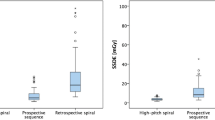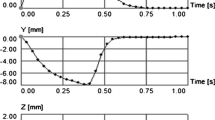Abstract
Objectives
To compare radiation exposure and image quality of second-generation 128-slice dual-source CT (DSCT) coronary angiography (cCTA) protocols.
Materials and methods
We retrospectively analyzed data from four groups with 25 patients, each examined by one of the following DSCT cCTA protocols: prospectively ECG-gated high-pitch (group 1) or sequential (group 2) acquisition, retrospectively ECG-gated acquisition in dual-energy (DECT, group 3) or dual-source (group 4) mode. CT dose index volume, dose length product, estimated radiation dose, contrast-to-noise- and signal-to-noise-ratios were compared. Subjective image quality was rated by two observers blinded to the protocols.
Results
High-pitch DSCT showed a mean estimated radiation dose of 1.27 ± 0.62 mSv, significantly (p < 0.01) lower than sequential (2.04 ± 0.94 mSv), dual-energy (3.97 ± 1.29 mSv) or dual-source (8.11 ± 4.95 mSv) acquisition. Image noise showed no statistical difference (p > 0.91), ranging from 15.2 ± 4.4 (group 2) up to 24.5 ± 22.0 (group 4). Each protocol showed diagnostic image quality in at least 98.1 % of evaluated coronary segments without significant differences (p > 0.05).
Conclusions
Prospectively ECG-gated DSCT protocols enable cCTA with significant dose reduction and consistently diagnostic image quality. In patients requiring retrospectively ECG-gated DSCT for functional analysis or due to arrhythmia, dual-energy mode should be preferred over dual-source mode as it significantly decreases estimated dose without compromising image quality.




Similar content being viewed by others
Abbreviations
- CAD:
-
Coronary artery disease
- cCTA:
-
Coronary computed tomography angiography
- CNR:
-
Contrast-to-noise-ratio
- CTDIvol :
-
Volume computed tomography index
- DECT:
-
Dual-energy computed tomography
- DLP:
-
Dose length product
- DSCT:
-
Dual-source computed tomography
- ECG:
-
Electrocardiogram
- LCA:
-
Left coronary artery
- RCA:
-
Right coronary artery
- ROI:
-
Region of interest
- SD:
-
Standard deviation
- SNR:
-
Signal-to-noise-ratio
References
Budoff MJ, Achenbach S, Blumenthal RS, Carr JJ, Goldin JG, Greenland P et al (2006) Assessment of coronary artery disease by cardiac computed tomography: a scientific statement from the American heart association committee on cardiovascular imaging and intervention, council on cardiovascular radiology and intervention, and committee on cardiac imaging, council on clinical cardiology. Circulation 114:1761–1791
Hendel RC, Patel MR, Kramer CM, Poon M, Hendel RC, Carr JC et al (2006) ACCF/ACR/SCCT/SCMR/ASNC/NASCI/SCAI/SIR 2006 appropriateness criteria for cardiac computed tomography and cardiac magnetic resonance imaging: a report of the American College of Cardiology Foundation Quality Strategic Directions Committee Appropriateness Criteria Working Group, American College of Radiology, Society of Cardiovascular Computed Tomography, Society for Cardiovascular Magnetic Resonance, American Society of Nuclear Cardiology, North American Society for Cardiac Imaging, Society for Cardiovascular Angiography and Interventions, and Society of Interventional Radiology. J Am Coll Cardiol 48:1475–1497
Leschka S, Stolzmann P, Desbiolles L, Baumueller S, Goetti R, Schertler T et al (2009) Diagnostic accuracy of high-pitch dual-source CT for the assessment of coronary stenoses: first experience. Eur Radiol 19:2896–2903
Paul J-F, Abada HT (2007) Strategies for reduction of radiation dose in cardiac multislice CT. Eur Radiol 17:2028–2037
Alkadhi H, Stolzmann P, Scheffel H, Desbiolles L, Baumüller S, Plass A et al (2008) Radiation dose of cardiac dual-source CT: the effect of tailoring the protocol to patient-specific parameters. Eur J Radiol 68:385–391
Rist C, Johnson TR, Müller-Starck J, Arnoldi E, Saam T, Becker A et al (2009) Noninvasive coronary angiography using dual-source computed tomography in patients with atrial fibrillation. Invest Radiol 44:159–167
Alkadhi H, Scheffel H, Desbiolles L, Gaemperli O, Stolzmann P, Plass A et al (2008) Dual-source computed tomography coronary angiography: influence of obesity, calcium load, and heart rate on diagnostic accuracy. Eur Heart J 29:766–776
Woodard PK (2005) Science to practice: can multi-detector row spiral CT be used to assess left ventricular function? Radiology 236:1–2
Juergens KU, Fischbach R (2006) Left ventricular function studied with MDCT. Eur Radiol 16:342–357
Flohr TG, McCollough CH, Bruder H, Petersilka M, Gruber K, Süss C et al (2006) First performance evaluation of a dual-source CT (DSCT) system. Eur Radiol 16:256–268
Stolzmann P, Scheffel H, Schertler T, Frauenfelder T, Leschka S, Husmann L et al (2008) Radiation dose estimates in dual-source computed tomography coronary angiography. Eur Radiol 18:592–599
Chen H, Fang X, Hu X, Bao J, Hu C, Chen Y et al (2010) Efficacy of dual-source CT coronary angiography in evaluating coronary stenosis: initial experience. Clin Imaging 34:165–171
Kerl JM, Ravenel JG, Nguyen SA, Suranyi P, Thilo C, Costello P et al (2008) Right heart: split-bolus injection of diluted contrast medium for visualization at coronary CT angiography. Radiology 247:356–364
Nance JW Jr, Bastarrika G, Kang DK, Ruzsics B, Vogt S, Schmidt B et al (2011) High-temporal resolution dual-energy computed tomography of the heart using a novel hybrid image reconstruction algorithm: initial experience. J Comput Assist Tomogr 35:119–125
Huda W, Ogden KM, Khorasani MR (2008) Converting dose-length product to effective dose at CT. Radiology 248:995–1003
Kerl JM, Bauer RW, Maurer TB, Aschenbach R, Korkusuz H, Lehnert T et al (2011) Dose levels at coronary CT angiography—a comparison of dual Energy-, dual Source- and 16-slice CT. Eur Radiol 21:530–537
Boone J, Strauss K, Cody D, McCollough CH, McNitt-Gray MF, Toth TL, et al. (2011) Size-specific dose estimates (SSDE) in pediatric and adult body CT examinations. Report of Am. Assoc. Phys. Med. AAPM Task Group 204. College Park, Md: American Association of Physicists in Medicine
Cerqueira MD, Weissman NJ, Dilsizian V, Jacobs AK, Kaul S, Laskey WK et al (2002) Standardized myocardial segmentation and nomenclature for tomographic imaging of the heart. A statement for healthcare professionals from the Cardiac Imaging Committee of the Council on Clinical Cardiology of the American Heart Association. Circulation 105:539–542
Achenbach S, Marwan M, Ropers D, Schepis T, Pflederer T, Anders K et al (2010) Coronary computed tomography angiography with a consistent dose below 1 mSv using prospectively electrocardiogram-triggered high-pitch spiral acquisition. Eur Heart J 31:340–346
Yin W-H, Lu B, Hou Z-H, Li N, Han L, Wu Y-J et al (2013) Detection of coronary artery stenosis with sub-milliSievert radiation dose by prospectively ECG-triggered high-pitch spiral CT angiography and iterative reconstruction. Eur Radiol 23:2927–2933
Schuhbaeck A, Achenbach S, Layritz C, Eisentopf J, Hecker F, Pflederer T et al (2013) Image quality of ultra-low radiation exposure coronary CT angiography with an effective dose <0.1 mSv using high-pitch spiral acquisition and raw data-based iterative reconstruction. Eur Radiol 23:597–606
Kim JS, Choo KS, Jeong DW, Chun KJ, Park YH, Song SG et al (2011) Step-and-shoot prospectively ECG-gated vs. retrospectively ECG-gated with tube current modulation coronary CT angiography using 128-slice MDCT patients with chest pain: diagnostic performance and radiation dose. Acta Radiol 52:860–865
Jeong DW, Choo KS, Baik SK, Kim YW, Jeon UB, Kim JS et al (2011) Step-and-shoot prospectively ECG-gated versus retrospectively ECG-gated with tube current modulation coronary CT angiography using the 128-slice MDCT: comparison of image quality and radiation dose. Acta Radiol 52:155–160
Ruzsics B, Lee H, Zwerner PL, Gebregziabher M, Costello P, Schoepf UJ (2008) Dual-energy CT of the heart for diagnosing coronary artery stenosis and myocardial ischemia-initial experience. Eur Radiol 18:2414–2424
Meinel FG, De Cecco CN, Schoepf UJ, Nance JW Jr, Silverman JR, Flowers BA et al (2014) First-arterial-pass dual-energy CT for assessment of myocardial blood supply: do we need rest, stress, and delayed acquisition? comparison with SPECT. Radiology 270:708–716
Wichmann JL, Bauer RW, Doss M, Stock W, Lehnert T, Bodelle B et al (2013) Diagnostic accuracy of late iodine-enhancement dual-energy computed tomography for the detection of chronic myocardial infarction compared with late gadolinium-enhancement 3-T magnetic resonance imaging. Invest Radiol 48:851–856
Maffei E, Messalli G, Martini C, Nieman K, Catalano O, Rossi A et al (2012) Left and right ventricle assessment with cardiac CT: validation study vs. cardiac MR. Eur Radiol 22:1041–1049
Arraiza M, Azcárate PM, De Cecco CN, Viteri G, Simón-Yarza I, Hernández-Estefanía R et al (2012) Assessment of left ventricular parameters in orthotopic heart transplant recipients using dual-source CT and contrast-enhanced echocardiography: comparison with MRI. Eur J Radiol 81:3282–3288
Seneviratne SK, Truong QA, Bamberg F, Rogers IS, Shapiro MD, Schlett CL et al (2010) Incremental diagnostic value of regional left ventricular function over coronary assessment by cardiac computed tomography for the detection of acute coronary syndrome in patients with acute chest pain: from the ROMICAT trial. Circ Cardiovasc Imaging 3:375–383
Takx RAP, Moscariello A, Schoepf UJ, Barraza JM Jr, Nance JW Jr, Bastarrika G et al (2012) Quantification of left and right ventricular function and myocardial mass: comparison of low-radiation dose 2nd generation dual-source CT and cardiac MRI. Eur J Radiol 81:e598–e604
Renker M, Nance JW Jr, Schoepf UJ, O’Brien TX, Zwerner PL, Meyer M et al (2011) Evaluation of heavily calcified vessels with coronary CT angiography: comparison of iterative and filtered back projection image reconstruction. Radiology 260:390–399
Conflict of interest
Ralf W. Bauer and J. Matthias Kerl are on the speakers’ bureau of Siemens Healthcare, Computed Tomography division. However, both co-authors did not analyze or control any data in this study. All other authors have nothing to disclose.
Ethical standards
This retrospective study was approved with waiver of the requirement for informed consent.
Author information
Authors and Affiliations
Corresponding author
Rights and permissions
About this article
Cite this article
Wichmann, J.L., Hu, X., Engler, A. et al. Dose levels and image quality of second-generation 128-slice dual-source coronary CT angiography in clinical routine. Radiol med 120, 1112–1121 (2015). https://doi.org/10.1007/s11547-015-0546-9
Received:
Accepted:
Published:
Issue Date:
DOI: https://doi.org/10.1007/s11547-015-0546-9




